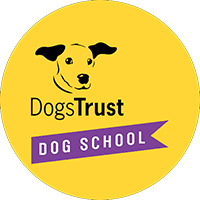Why should I train my dog?
Dogs love the physical and mental stimulation of training, but these sessions can also offer all sorts of other benefits to you and your dog including:
- Helping you meet your training goals
- Establishing a strong relationship with your dog
- Making it easier to keep your dog safe
- Opening the door to more advanced training
Which dog training technique should I use?
Positive reinforcement is one of the most effective (and fun!) training techniques. It relies on the use of a reward, often dog training treats, to help encourage your dog to follow specific cues. You’ll need rewards and a marker word to let your dog know when they get something right.
Before you start training, read our guide to reward based training to find out more about this technique, including how to choose the right reward for your dog and how to introduce them to a marker. A marker is a signal that lets your dog know they’ve done what you asked and forms a key part of training new behaviours.
Remember that every dog is different. They all learn at their own pace and in the way that suits them best. Patience along with consistent, short training sessions will help you reach your goals.
What is luring and how to use a lure in dog training
A lure is a treat that your dog really wants, like a small piece of cheese, homemade treat, or cooked chicken. Imagine this lure as a ‘magnet’ that you can hold in your hand for your dog to follow into different positions.
Using a lure as part of your rewards-based training helps make it easy for your dog to understand the behaviour and body position they’ll be rewarded for. This technique can be used for basic commands like sit and down, all the way up to more complicated movements like spin and touch.
Teaching your dog to sit
Step 1
Hold a treat in your hand and show it to your dog so they can see and smell it. You want their attention focused on the treat — so if they don’t seem interested you might need to try a tastier, higher-value reward.
Place your hand in front of your dog’s nose and draw it up and over their head. As your dog’s head moves up and back their body should naturally go into a sit position. As soon as your dog sits, say your marker word and give them their reward. Repeat this step until your dog is consistently following the lure/treat into a sitting position.
Step 2
Now you can start removing the food from your hand, so that your dog learns how to do the behaviour when you don’t have food on you. To do this, pretend to get a treat out of your pocket and hold your hand as if it was concealing the treat. Repeat the same luring action from the previous step. As your dog sits, use your marker word and then reward them with a treat out of your pocket. At this stage, it’s still important to reward your dog with food! Continue with this step until your dog consistently sits even when your hand is empty.
Step 3
Now you can add a verbal cue, which usually ‘sit’ but you can use any word you like as long as you’re consistent. Say your word ‘sit’, wait a few moments and as before, move your hand up to guide your dog into position. Mark and reward your dog when they get it right. Keep practising this step, but make your hand movement smaller and smaller. Your dog should start sitting at the verbal cue, even before you move your hand.
Step 4
Now you can start practising this cue in a more challenging environment (we’ve given you some ideas for this below). If your dog starts to find it hard, go back to the previous step and give them plenty of encouragement before trying again.
Teaching your dog to lie down
Step 1
Once your dog is confident sitting, you can move onto training them to lie down. Hold a treat in your hand and ask your dog to sit. Next, lower your hand to the floor between your dog’s front paws. Your dog will follow the movement of the treat and lie down. As soon as they do, use your marker word and reward them.
Step 2
As with the sit cue, once your dog is consistently following the treat lure into a lying down position, you can start to remove the food from your hand. Use the same hand movement as step one and then offer a treat from your pocket when your dog lies down.
Step 3
Now’s the time to introduce a verbal cue of your choice. Again, say this just before you move your hand to lure your dog into position. Gradually reduce the size of your hand signal until your dog can respond to your verbal word only.
Step 4
Once your dog is naturally lying down quickly and easily at home, you can try the same cues in different environments.


